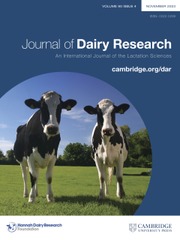Article contents
51. The Plate Method of Estimating the Bacterial Content of Milk—the Limitations of Procedure in Common Use, with Suggested Improvements
Published online by Cambridge University Press: 01 June 2009
Extract
The plating method of estimating the bacterial content of milk is the most important means of determining the number of living organisms present, and is the one most frequently employed. It is well recognised, however, that accurate counts cannot be obtained by this method, since considerable errors may be involved through the difficulty of ensuring the separation of chains and clusters of organisms so that each organism is represented by a separate colony, through the inability of some classes of bacteria to grow on the medium employed, and through the fact that the presence of one group of organisms may inhibit the growth of others—particularly on crowded plates. It appears that the difficulties in obtaining uniformity of counts for duplicate tests may be increased in the case of milk because this fluid is heterogeneous in nature, and the bacterial contaminants are liable to occur not only as groups or individuals freely dispersed in the liquid but also in association with matter in suspension, especially the clusters of fat globules. Consequently the bacterial counts are likely to vary with the extent to which the clusters of fat globules are broken up or aggregated by the manipulations.
- Type
- Original Articles
- Information
- Copyright
- Copyright © Proprietors of Journal of Dairy Research 1932
References
REFERENCES
- 5
- Cited by


